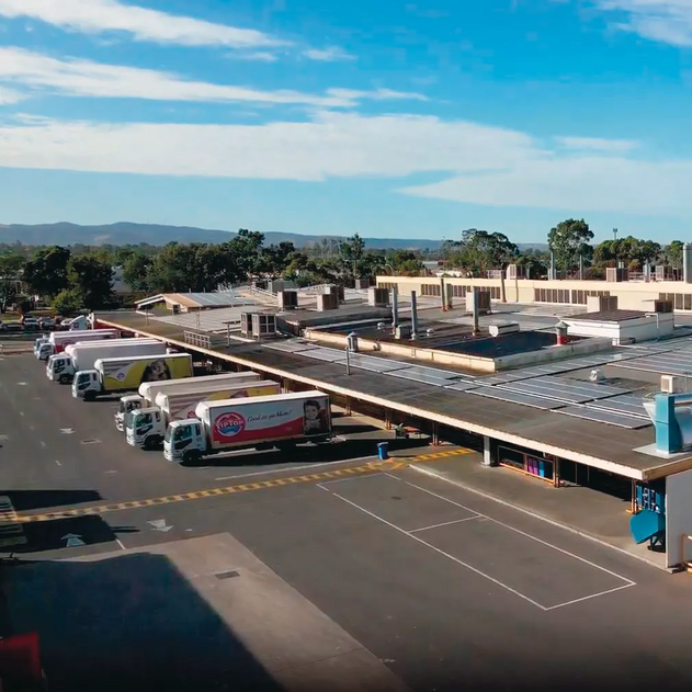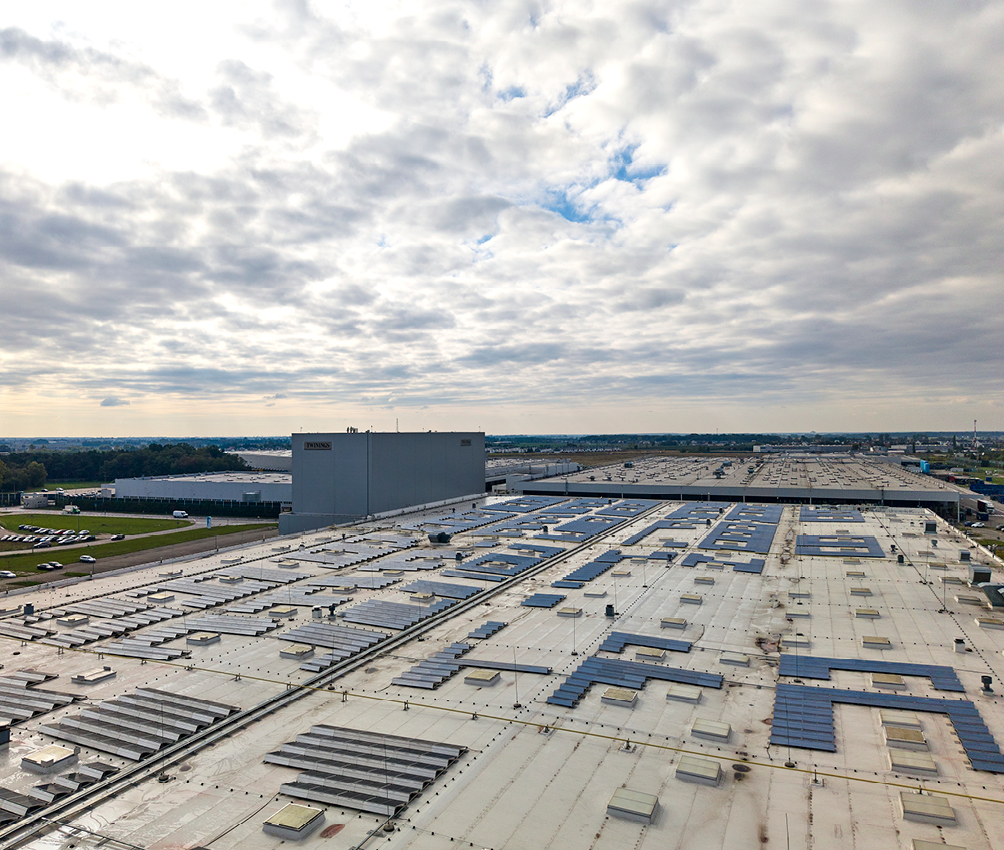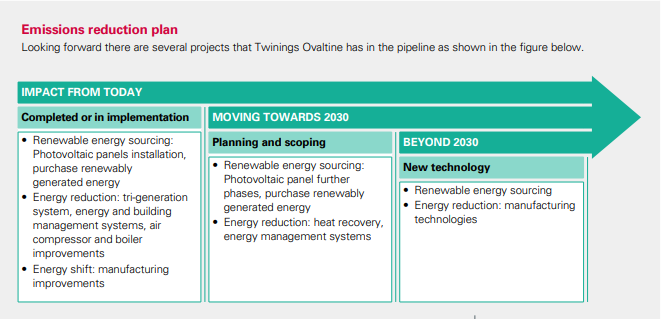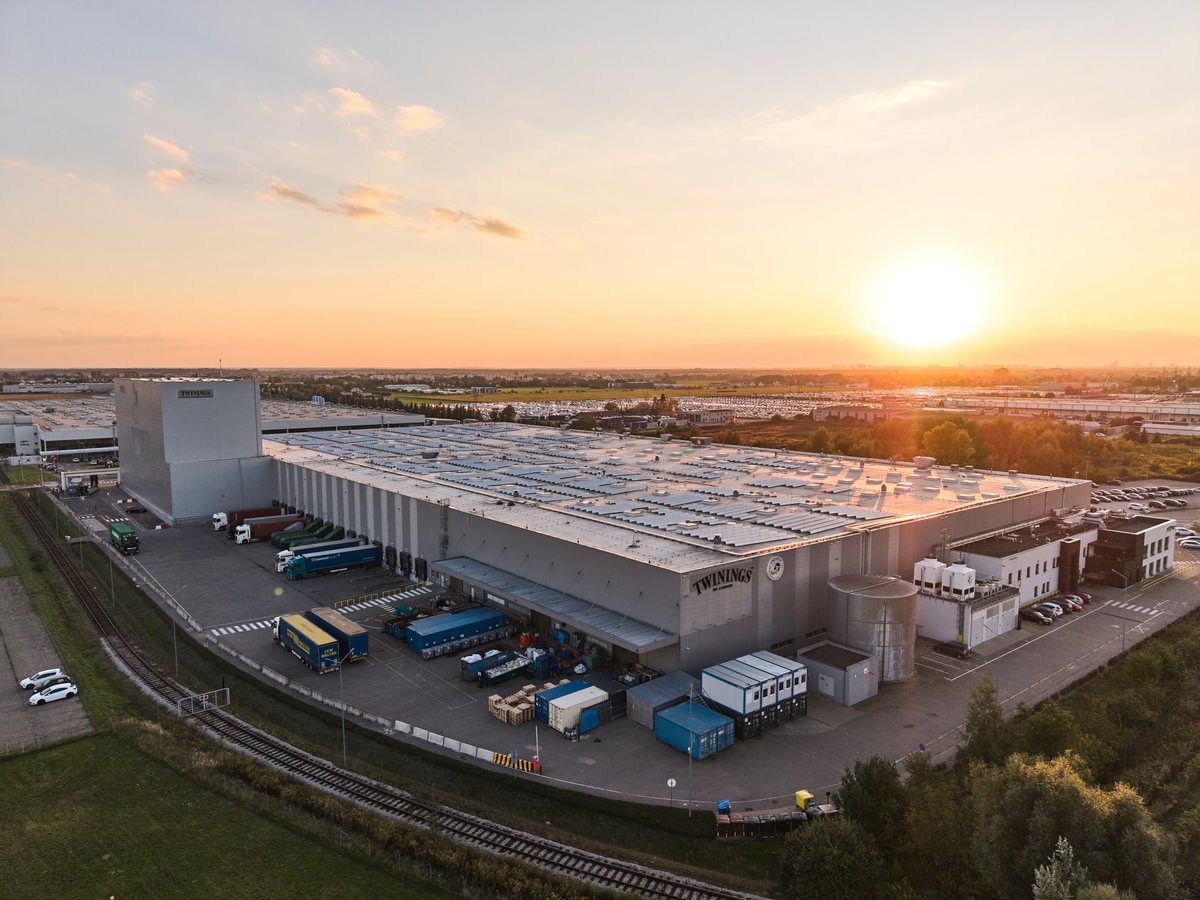About Us
Our Businesses
Investors
Responsibility
Media
Careers
Our Grocery businesses are addressing the risks associated with climate change by focusing on reducing energy use and emissions while also preparing for regulatory changes.
 Solar panels, George Weston Foods, Australia
Solar panels, George Weston Foods, Australia
Our Grocery businesses are improving energy efficiency and increasing their use of renewable energy to reduce greenhouse gas emissions and costs.
In 2025, across our Grocery businesses, energy consumption decreased by 10% and Scope 1 and 2 market-based GHG emissions decreased by 9% compared to 2024.
The Grocery Group UK businesses are signatories to the UK Food and Drink Pact, which outlines an ambitious set of industry-wide targets aligned to the 1.5°C pathway and a commitment to achieve net zero emissions by 2050. These businesses have committed to reduce emissions by 50% across Scope 1, 2, and 3 by 2030 against a 2015 baseline, in line with the UK Food and Drink Pact commitment.
In 2024, AB World Foods committed to near-term, business-wide absolute emission reductions to 2031 through the Science Based Target Initiative (SBTi), aligned to the 1.5°C pathway.
The Grocery Group’s total energy consumption for 2025 was 416GWh, a decrease of 7% compared with 448GWh in 2024. Of the total energy consumed, 10% came from renewable sources. In 2024, the Acetum business in Italy installed 694 photovoltaic panels at the San Felice site, significantly increasing the share of energy generated from renewable sources. The system is expected to produce between 150-200MWh annually, supporting one of the division’s most energy-intensive sites, where vinegar fermenters operate continuously.
Grocery Group Scope 1 emissions decreased by 19% compared to 2024, primarily due to energy efficiency projects, and total Scope 1 and 2 market-based GHG emissions decreased by 7%.
Grocery Group’s UK businesses achieved a decrease of 50% in their total Scope 1 and 2 market-based GHG emissions compared to the 2015 baseline. These reductions have been driven by operational structure changes, investment in renewable energy and ongoing capital investment in more efficient equipment.
All Grocery Group businesses have started work to map and calculate their Scope 3 emissions.
Twinings Ovaltine recognises the risk climate change poses to its business and supply chains and has set near and long-term science-based targets, with a commitment to reach net zero by 2050. These targets and this commitment are in line with limiting global warming to within 1.5°C, and have been validated by the Science Based Targets initiative (SBTi).
Addressing climate change is particularly important for the gardens, farms and communities that grow its raw materials, as extreme weather and natural disasters like heat waves, irregular rainfall, flooding and drought, continue to affect the growing of healthy crops and the livelihoods of communities who rely on them.
In 2025, Twinings Ovaltine's total energy consumption was 153GWh, reflecting a 4% increase from 2024. Of this total, 7% was sourced from renewable energy sources. The division’s Scope 1 and 2 market-based GHG emissions decreased by 3% compared to 2024. This was driven by more efficient use of electricity as well as the purchase of greener electricity.
Twinings Ovaltine has started work to map and verify its Scope 3 emissions. Further information about Twinings is available on its Sourced with Care website.
George Weston Foods recognises the importance of contributing to the transition to a low-carbon economy and managing its climate risks and impacts. It is also preparing to meet regulatory requirements under Australia’s new Climate-Related Financial Disclosure regime, which came into effect on 1 January 2025.
In 2025, Scope 1 and 2 market-based GHG emissions totalled 179kt CO₂e, a 1% decrease from the previous year. This reduction was driven by site-level energy efficiency initiatives and equipment upgrades implemented across the division, as well as an increase in use of renewable energy.
Tip Top continues to install solar arrays at its bakeries across Australia. The business has already installed solar panels at its Townsville, Bendigo, Dry Creek, Carrara, and Chullora bakeries. In New Zealand, Tip Top has replaced gas ovens with new electric ovens in its gluten-free bakery, resulting in a 64% reduction in CO₂ emissions for bread production.
ACH’s total energy consumption for 2025 was 14GWh and the business reported 5kt of Scope 1 and 2 market-based GHG emissions.
| 2021 | 2022 | 2023 | 2024 | 2025 | |
|---|---|---|---|---|---|
| Grocery | 1464 | 1310 | 1266 | 1235 | 1109 |
| Percentage of total energy | 0% | 6% | 4% | 5% | 5% |
| 2021 | 2022 | 2023 | 2024 | 2025 | |
|---|---|---|---|---|---|
| Scope 1 | 271 | 231 | 203 | 195 | 157 |
| Scope 2 (market-based) | 214 | 192 | 201 | 190 | 192 |
EDITOR NOTE:
This is the modal area for the above carousel. Please be careful when copying this to UAT or PROD. It would be best to include Cian in these movements. The carousel above has buttons which have ID tags which open the below containers. Be careful to maintain the ID tags.
Twinings Ovaltine commits to reach net-zero greenhouse gas emissions across the value chain by 2050.
Energy & Industry: Twinings Ovaltine commits to reduce absolute Scope 1 and 2 GHG emissions by 42% by 2030 from a 2020 base year. Twinings Ovaltine also commits to reduce absolute Scope 3 GHG emissions by 42% within the same timeframe.
FLAG: Twinings Ovaltine commits to reduce absolute Forest, Land and Agriculture (FLAG) Scope 3 GHG emissions by 30.3% by 2030 from a 2020 base year*. Twinings Ovaltine commits to no deforestation across its primary deforestation-linked commodities, with a target date of 31 December 2025.
Energy & Industry: Twinings Ovaltine commits to reduce absolute Scope 1 and 2 GHG emissions by 90% by 2050 from a 2020 base year. Twinings Ovaltine also commits to reduce absolute Scope 3 GHG emissions by 90% within the same timeframe.
FLAG*: Twinings Ovaltine commits to reduce absolute FLAG Scope 3 GHG emissions by 72% by 2050 from a 2020 base year*.
*Target includes FLAG emissions and removals.

Solar panels on the roof at the Twinings manufacturing facility in Swarzędz, Poland
Energy & Industry: AB World Foods commits to reduce absolute Scope 1 and 2 GHG emissions by 46.2% by 2031 from a 2021 base year. AB World Foods also commits to reduce absolute Scope 3 GHG emissions from purchased goods and services, fuel and energy-related activities, and upstream transportation and distribution by 27.5% within the same timeframe.
FLAG: AB World Foods commits to reduce absolute Scope 3 Forest, Land and Agriculture (FLAG) GHG emissions by 33.3% by 2031 from a 2021 base year*. AB World Foods also commits to no deforestation across its primary deforestation-linked commodities with a target date of 31 December 2025.
*Target includes FLAG emissions and removals.

Blue Dragon Original Sweet Chilli Sauce produced by AB World Foods
The overall accountability for Twinings Ovaltine’s transition plan lies with the Twinings Ovaltine Chief Executive and the Chief Financial Officer. Implementation is the responsibility of the Environmental Steering Committee, a cross-functional project management team including the five business leaders who represent the five main contributors to Twinings Ovaltine’s carbon emissions: its manufacturing facilities, packaging, logistics, tea, herbs and the raw materials and ingredients for Ovaltine.
Individuals responsible for delivering the ESG strategy are incentivised through their annual personal objectives and contributions.
Twinings Ovaltine meets periodically with ABF to discuss material climate-related topics. The Twinings Ovaltine Chief Executive and Chief Financial Officer are responsible for effective risk management of climate-related risks, opportunities, overall strategy and transition plans.
To ensure oversight and progress against plans, the business has a formal governance process for managing ESG risk through quarterly ESG Governance meetings, supported by outputs of the Environmental Steering Committee. The business leaders who are accountable for identifying, assessing and managing risks to deliver the transition plan, form part of the Environmental Steering Committee and attend its quarterly meetings.
These meetings focus on the implementation of the climate-related strategy and are a formal opportunity to discuss progress and challenges. This provides a forum to raise concerns around pertinent emerging climate-related risks, identified and assessed through horizon scanning, salient risk reviews, third-party research and insights, and internal expertise, particularly from procurement.
In 2022, the Group impact of climate risks relating to Twinings Ovaltine was assessed as being low by the ABF centre following scenario analysis performed in line with TCFD guidelines. In 2025, Twinings Ovaltine completed a double materiality assessment, in line with the European Sustainability Reporting Standards, for several companies and their value chains, which confirmed that climate change is a material risk at the individual company level. No new material climate impacts and risks were identified in the process. Financial materiality risk assessment, including new legislation or taxes, are completed locally every quarter and built into the overall business risk review.
Addressing climate change is a key pillar of Twinings Ovaltine’s ESG strategy. The SBTi has approved and independently validated Twinings Ovaltine’s near-and long-term science-based emissions targets and the business’ commitment to achieve net zero across its value chain by 2050. It has also validated the near-term commitment to an absolute reduction in their Scope 1 and 2 GHG emissions of 42% by 2030.
To achieve its Scope 1 and 2 commitment, Twinings Ovaltine has categorised its plans and projects into three focus areas of renewable energy sourcing, energy usage reduction and energy shifts through technology.

Twinings Ovaltine’s Scope 1 and 2 emissions represent 2% of total Group emissions. Since its baseline financial year 2020, Twinings Ovaltine has implemented projects to achieve a 21% reduction, 50% of its 2030 target. Investment in transition projects to date are £10.4m, through:
Project |
|
Renewable Energy: photovoltaic panels in the manufacturing facilities (Phase 1, 2, 3) |
Energy Reduction: Tri-generation |
Energy Shift: System technology change |
Energy Reduction: Energy management systems |
Renewable Energy: Purchased energy from renewably generated sources |
Energy Reduction: LED light bulbs |
GHG improvement |
6% |
5% |
8% |
2% |
8% |
< 1% |
|
Sites |
UK, Poland, Thailand, Switzerland and Australia |
Poland |
Thailand |
China and the UK |
Switzerland, Poland and Australia |
Poland, the UK Thailand and Switzerland |
|
Start year |
2023 |
2022 |
2024 |
2023 |
2024 |
2024 |
|
Description |
Installation of photovoltaic system for solar energy generation onto site roofing across all major production sites |
Installation of turbines producing electricity from natural gas, which is less carbon intensive than fossil fuels |
Technology and equipment change in key production stages to remove steam usage and improve use of condensers, shifting from LPG to lower CO2 energy source |
Technology and equipment measuring real time data to support improved building energy management and performance (data on energy intake and CO2 emission) |
Shifting energy provider to renewably generated sources. Switzerland shifted to hydropower in 2024, expected 3% savings. Poland wind power and Australia shifted late 2025 |
Essential replacement of light bulbs in the manufacturing facilities combined with installation of movement sensors to reduce unnecessary energy usage |
|
Total tCO2e savings (annual) |
2808 |
2430 |
3973 |
1022 |
3871 |
No visible CO2 benefits |
|
Underlying uncertainties, challenges and assumptions |
Risk – Weather reliance on solar energy source. Expected savings based on analysis at time of implementation, subject to production volume and weather fluctuations each year. These changes will be assessed with actual consumption tracking each year |
Risk in the increased exposure to natural gas prices. Opportunities are in alternative fuel use for higher efficiency |
Expected savings based on production process and volumes at time of implementation |
Real-time monitoring enables early identification of issues, resulting in increased efficiencies (e.g. identifying equipment failures through the system to prevent water wastage and gas leakage). Ongoing monitoring by a qualified production and energy management team |
Cost of renewable energy fluctuates depending on renewable generation variability and seasonal demand |
|
|
Progress to date (narrative) |
Completed phases 1 and 2. Phase 3 in progress |
Completed |
Completed |
Completed |
Completed in Switzerland, Poland and Australia. The UK is in progress |
Completed in Poland, the UK and Thailand; in delivery in Switzerland |
|
Project close out date |
September 2026 |
October 2023 |
May 2025 |
February 2024 |
December 2025 |
December 2025 |

Solar panels on the roof at the Twinings manufacturing facility in Swarzędz, Poland